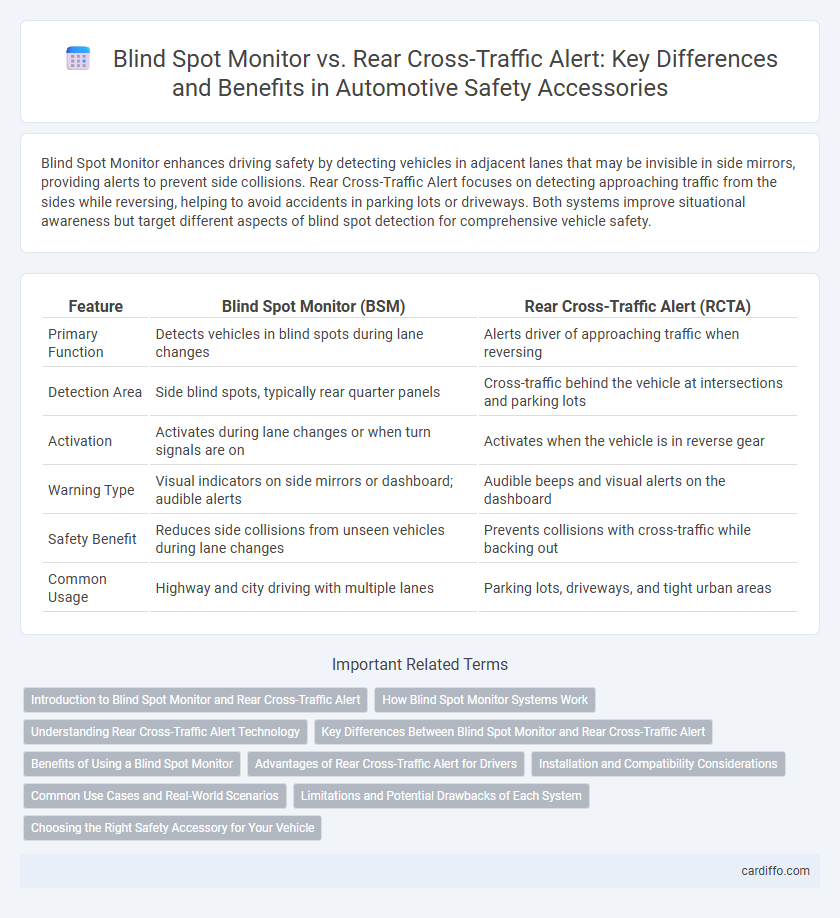Blind Spot Monitor enhances driving safety by detecting vehicles in adjacent lanes that may be invisible in side mirrors, providing alerts to prevent side collisions. Rear Cross-Traffic Alert focuses on detecting approaching traffic from the sides while reversing, helping to avoid accidents in parking lots or driveways. Both systems improve situational awareness but target different aspects of blind spot detection for comprehensive vehicle safety.
Table of Comparison
| Feature | Blind Spot Monitor (BSM) | Rear Cross-Traffic Alert (RCTA) |
|---|---|---|
| Primary Function | Detects vehicles in blind spots during lane changes | Alerts driver of approaching traffic when reversing |
| Detection Area | Side blind spots, typically rear quarter panels | Cross-traffic behind the vehicle at intersections and parking lots |
| Activation | Activates during lane changes or when turn signals are on | Activates when the vehicle is in reverse gear |
| Warning Type | Visual indicators on side mirrors or dashboard; audible alerts | Audible beeps and visual alerts on the dashboard |
| Safety Benefit | Reduces side collisions from unseen vehicles during lane changes | Prevents collisions with cross-traffic while backing out |
| Common Usage | Highway and city driving with multiple lanes | Parking lots, driveways, and tight urban areas |
Introduction to Blind Spot Monitor and Rear Cross-Traffic Alert
Blind Spot Monitor uses radar sensors to detect vehicles in adjacent lanes, alerting drivers to potential hazards during lane changes. Rear Cross-Traffic Alert scans the area behind the vehicle when reversing, warning of approaching traffic or obstacles that may be out of the driver's direct view. Both systems enhance safety by reducing collision risk through real-time vehicle detection and driver notification.
How Blind Spot Monitor Systems Work
Blind Spot Monitor systems use radar sensors or cameras to detect vehicles in adjacent lanes that may be hidden from the driver's view, providing real-time visual or audible alerts to prevent collisions during lane changes. These sensors continuously scan blind spots, typically on both sides of the vehicle, enhancing safety by increasing driver awareness of nearby traffic. Unlike Rear Cross-Traffic Alert, which focuses on detecting approaching vehicles when reversing, Blind Spot Monitors actively monitor alongside traffic while driving forward.
Understanding Rear Cross-Traffic Alert Technology
Rear Cross-Traffic Alert technology uses radar sensors to detect approaching vehicles from the sides when reversing, enhancing safety by providing audible and visual warnings of potential collisions. Unlike Blind Spot Monitor systems that monitor adjacent lanes during forward driving, Rear Cross-Traffic Alert is specifically designed to mitigate blind spots behind the vehicle. This technology significantly reduces the risk of accidents in parking lots and tight spaces by alerting drivers to cross traffic they might not see.
Key Differences Between Blind Spot Monitor and Rear Cross-Traffic Alert
Blind Spot Monitor detects vehicles in adjacent lanes during lane changes, providing visual or auditory warnings to prevent collisions. Rear Cross-Traffic Alert scans the area behind the vehicle when reversing, alerting drivers to approaching traffic from either side. The primary distinction lies in Blind Spot Monitor's focus on lateral traffic while driving forward versus Rear Cross-Traffic Alert's emphasis on rearward safety during backing maneuvers.
Benefits of Using a Blind Spot Monitor
Blind Spot Monitor enhances driver safety by detecting vehicles in adjacent lanes that may be invisible in side mirrors, reducing the risk of collisions during lane changes. It provides real-time alerts, increasing situational awareness and enabling quicker reaction times. This system is especially beneficial on highways and busy roads, offering continuous monitoring without driver distraction.
Advantages of Rear Cross-Traffic Alert for Drivers
Rear Cross-Traffic Alert enhances driver safety by detecting approaching vehicles from the sides while reversing, significantly reducing the risk of collisions in parking lots and tight spaces. It provides audible and visual warnings, allowing drivers to react promptly to unseen cross-traffic, which Blind Spot Monitors typically do not cover during reverse maneuvers. This system is especially beneficial in busy urban environments where limited visibility increases the likelihood of accidents.
Installation and Compatibility Considerations
Blind Spot Monitor systems typically require integration with existing vehicle sensors and may demand professional installation to ensure accurate calibration and functionality. Rear Cross-Traffic Alert devices often involve sensors mounted on the rear bumper and can be compatible with a broader range of vehicle models but still benefit from expert installation for optimal performance. Compatibility varies based on make, model, and year, making it essential to verify system requirements and sensor placement before purchase.
Common Use Cases and Real-World Scenarios
Blind Spot Monitor enhances safety by detecting vehicles in adjacent lanes during lane changes, reducing side collision risks on highways and busy roads. Rear Cross-Traffic Alert is crucial when reversing out of parking spaces, alerting drivers to approaching traffic from either side. Both systems complement each other by covering distinct blind zones, improving overall situational awareness in urban and suburban driving environments.
Limitations and Potential Drawbacks of Each System
Blind Spot Monitor systems may struggle in heavy rain or snow, reducing sensor accuracy and increasing the risk of missed detections, while Rear Cross-Traffic Alert can generate false warnings in crowded parking lots due to its reliance on radar signals. Both systems can have limited effectiveness in detecting smaller or fast-moving objects, potentially leading to driver overreliance and reduced situational awareness. Understanding the limitations of these safety features is crucial to supplementing them with attentive driving practices.
Choosing the Right Safety Accessory for Your Vehicle
Blind Spot Monitor detects vehicles in adjacent lanes, providing alerts when changing lanes to prevent collisions. Rear Cross-Traffic Alert warns drivers of approaching traffic from the sides while reversing, enhancing safety in parking areas. Selecting the right safety accessory depends on your driving habits and typical road scenarios to reduce blind spots and improve rear visibility effectively.
Blind Spot Monitor vs Rear Cross-Traffic Alert Infographic

 cardiffo.com
cardiffo.com